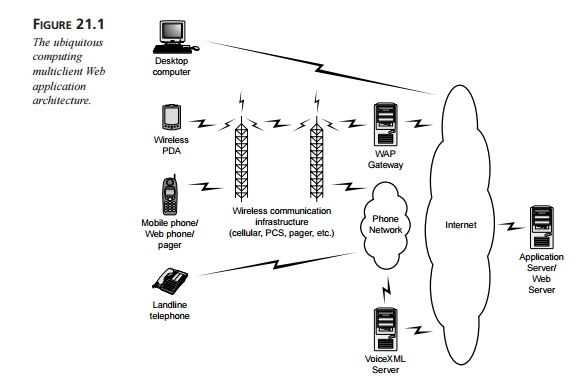Chapter: XML and Web Services : Applied XML : Delivering Wireless and Voice Services with XML
The Vision of Ubiquitous Computing
The Vision of Ubiquitous Computing
Three essential elements make up the vision of ubiquitous computing:
Anywhere access. Users are able to access
desired services from any location, using
whatever access device is convenient and appropriate for their current
situa-tion, including desktop computer, landline or mobile telephone, PDA,
pager, public Internet terminal, and so on.
Parallel and complementary modes of access. Parallel modes of access give users
more options regarding when, where, and how they access a given service. An
example of parallel modes of access would be a map and directions service that
may be accessed via a standard PC Web browser or on a Web phone while the user
is traveling. In this case, both modes of access have merits and are beneficial
to the user under different circumstances. On the other hand, with
complementary modes of access, a service is made accessible via a variety of
modes that work together to deliver the service. For example, complementary
modes of access would be found in a phonebook service where users can most
efficiently create and manage their contact information using a desktop PC but
access this information most efficiently via a Web phone.
Presentation-neutral application middleware. As shown in Figure 21.1, different
devices use different communication infrastructures, but they all access
the same application on the back-office server. It is essential, therefore, for
the applications running on that server to be “presentation neutral.” Separate
devices that are dedi-cated to supporting their corresponding interfaces best
handle the formatting of data for presentation. XML and XSL provide excellent
tools for implementing pre-sentation-neutral middleware.
Figure 21.1 shows four separate
access devices using different communication infrastruc-tures to access a
common application. A desktop user may use the standard Internet tech-nologies
of TCP/IP and HTTP to access the Internet directly. Alternately, a wireless
PDA, two-way pager, or mobile phone user may use one of many wireless communica-tion
infrastructures to access the Internet via a WAP gateway. The mobile phone
might also call into a VoiceXML gateway to interact with the common application
via voice, which is also possible from a landline phone.

Related Topics